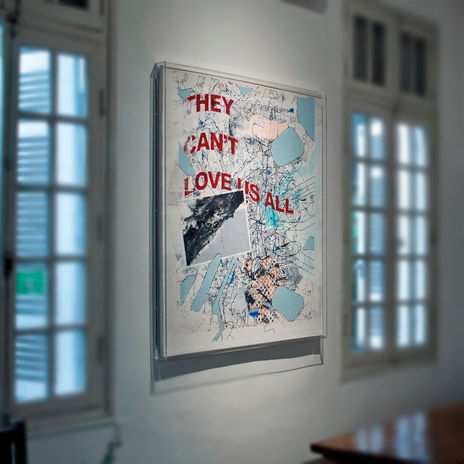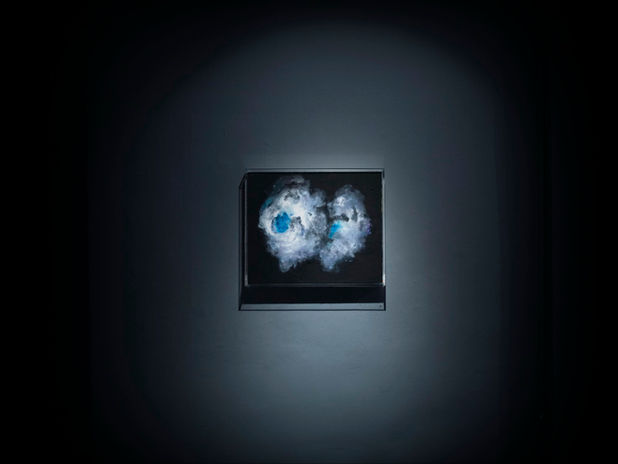
'Neo-Romanticism'
-
April 22, 2023
March 24, 2023
Lê Quý Tông
Featuring twenty mixed-media works on canvas and paper, ‘Neo-Romanticism’ marked the return of Lê Quý Tông to manzi after over seven years since his solo show titled ‘True Blue’ (2015) which saw the beginning of his on-going experiment with a ‘input hybrid’ of painting, decorated pattern and found imagery. Along with the participation of a new technique - screen printing in the artist’s practice, this comeback also sees a dramatic change in the color palettes: neither limited to monochromatic color schemes nor restrained in the deep, somber shades as in his previous series ‘True Blue’ and ‘True Gold’. ‘Neo-Romanticism’ witnesses a bloom in a wide variety of colors, including both bold and subtle, fiery and dusky hues. Yet, what to expect beyond the new method and palette which got an air of Pop Art Style? Further than just the outer expansion in visual accomplishment, can we find any pole vaulting in the inner of this artist’s latest expedition?
The first bar to jump over probably is the starting point of all Tông’s paintings - the photographic documentation. These images sourced from historical archives and mass media are easily accessible by an online image search engine. Rather than to intentionally select an image that would anchor his own composition and navigate the viewer’s perception, Lê Quý Tông randomly singles out a photo that he found intriguing as an input element; its original context is of very little significance. It varied from a reliable evidence of a momentous event influenced the course of history to a fragment of manipulative media & information / a dishonest journalistic recording of a person or a conflict (in the past or in the present). The visual source can also be recognizable imagery of popular culture (such as Marvel Comics an Disney characters) or may be borrowed from some religious illustrative motifs and even some propaganda posters. Taken out of their original context, these visual elements once have been appropriated, reassembled together into something beyond space and time which ultimately can erase all boundaries and opposite sides of the initial narratives - no longer exists the enemy, invader & comrade, patriot; justice of war & injustice in war, righteousness & moral weight are all nonsense in the disturbed situation of ‘Neo-Romanticism’.
ARTWORKS
GALLERY
_______________
Besides playing with the massive visual archives by deconstruction & collage, this new body of works by Lê Quý Tông confronts us with a series of new ‘KEYWORDS’ (that can be stated clearly in the form of letters, written texts or presented by figures, drawings) which are LOVE, HEART, ROMANTIC(ISM), DREAMER, ACROBAT , YOUTH,… These keywords, together with the overlapping lines, patterns and the bouncing colorful layers on the surface of canvas / paper, construct a particular aesthetic symbolism of the whole series. Then what we see is not ultimately the subjects to be interpreted. Instead, this system of symbols acts as an intermediary that stimulates our imagination and evokes our feelings, thus, thoughts and interpretations can be liberated from political, moral and cultural discourses.
Departing from a very specific, prejudiced starting point (available photographic material), through a labor-intensive process of working on layers after layers in which the patience was constantly pushed to the end, the results presented in ‘Neo-Romanticism' are disordered and somewhat abstract reflections, yet in one way or another approaching closer to the essence of the original images / archived reality? Can we see more clearly now when the sight is disturbed, as Roland Barthes suggested in his final book ‘Camera Lucida: Reflections on Photography’:
“Ultimately — or at the limit — in order to see a photograph well, it is best to look away or close your eyes. 'The necessary condition for an image is sight,'Janouch told Kafka; and Kafka smiled and replied: 'We photograph things in order to drive them out of our minds. My stories are a way of shutting my eyes.”
From this perspective, the art practice by Lê Quý Tông offers us a way “to shut our eyes”, and therefore, enable us to resist the dominance and manipulation of the visual information in our chaotic modern age. This also proposes a liberation for Tông himself, in a role of an artist, as a creator of new and an interpreter of the past; he can finally free himself out of the conundrum to justify and represent the questioned-by-him reality, time, history, and memories,.... as in the series ‘True Blue’. With ‘Neo-Romanticism’ the artist has put on a pair of spiritual wings, youthful, audacious; he now embraces both life (past and present) and human beings as a tangle of reality and illusion, passion and brutality, authenticity and violence. Such a bold move, though resulting in a new demanding task imposed on the artist: he must maintain the balance constantly, try not to fall into either side: prophetic pessimism on one hand or tremendous optimism on the other. The situation now is comparable to Lê Quý Tông’s own painting in which we see an acrobat, a dreamer who strives to keep on dreaming while knowing that he is dreaming.
OPENING NIGHT

































